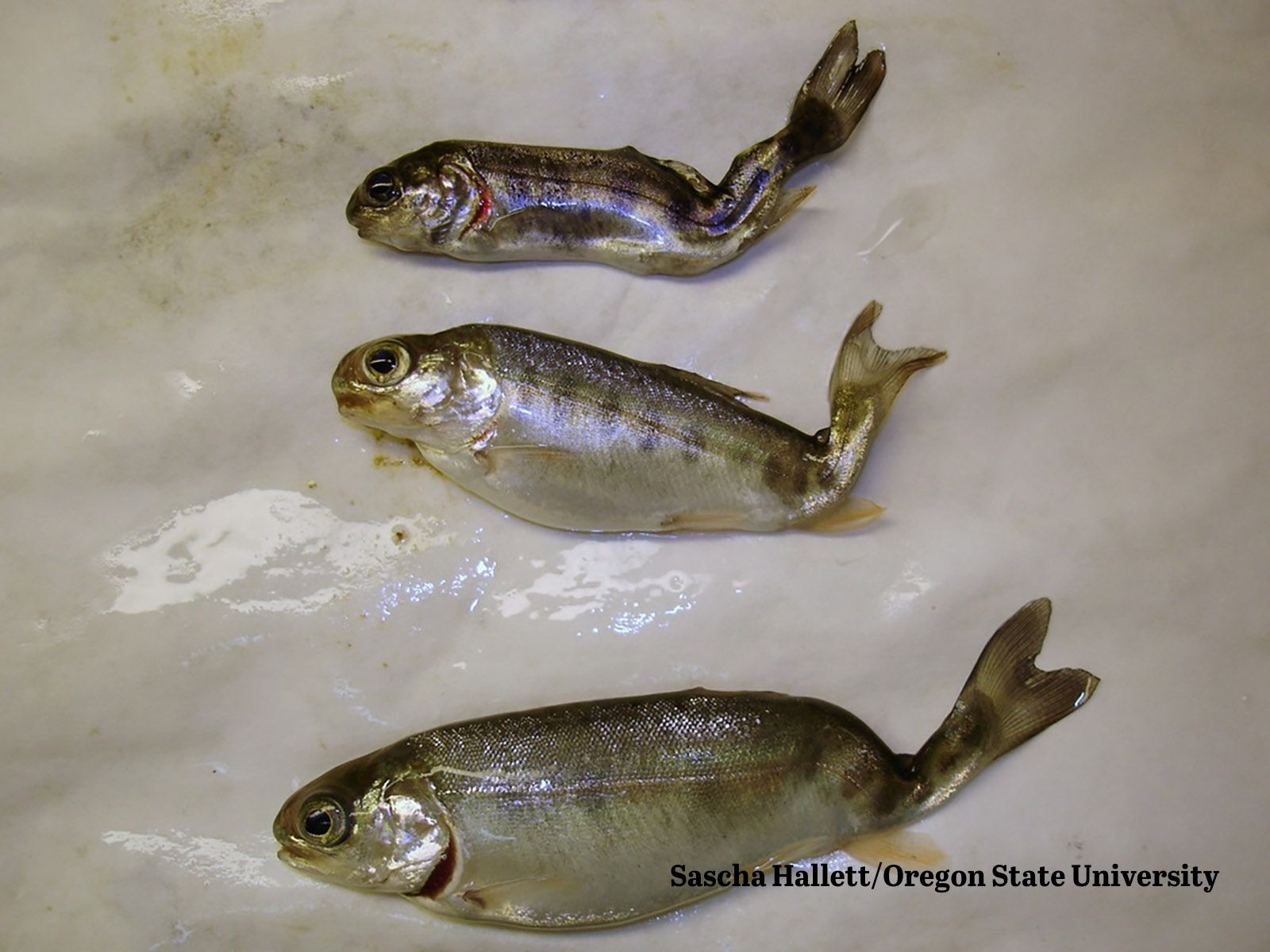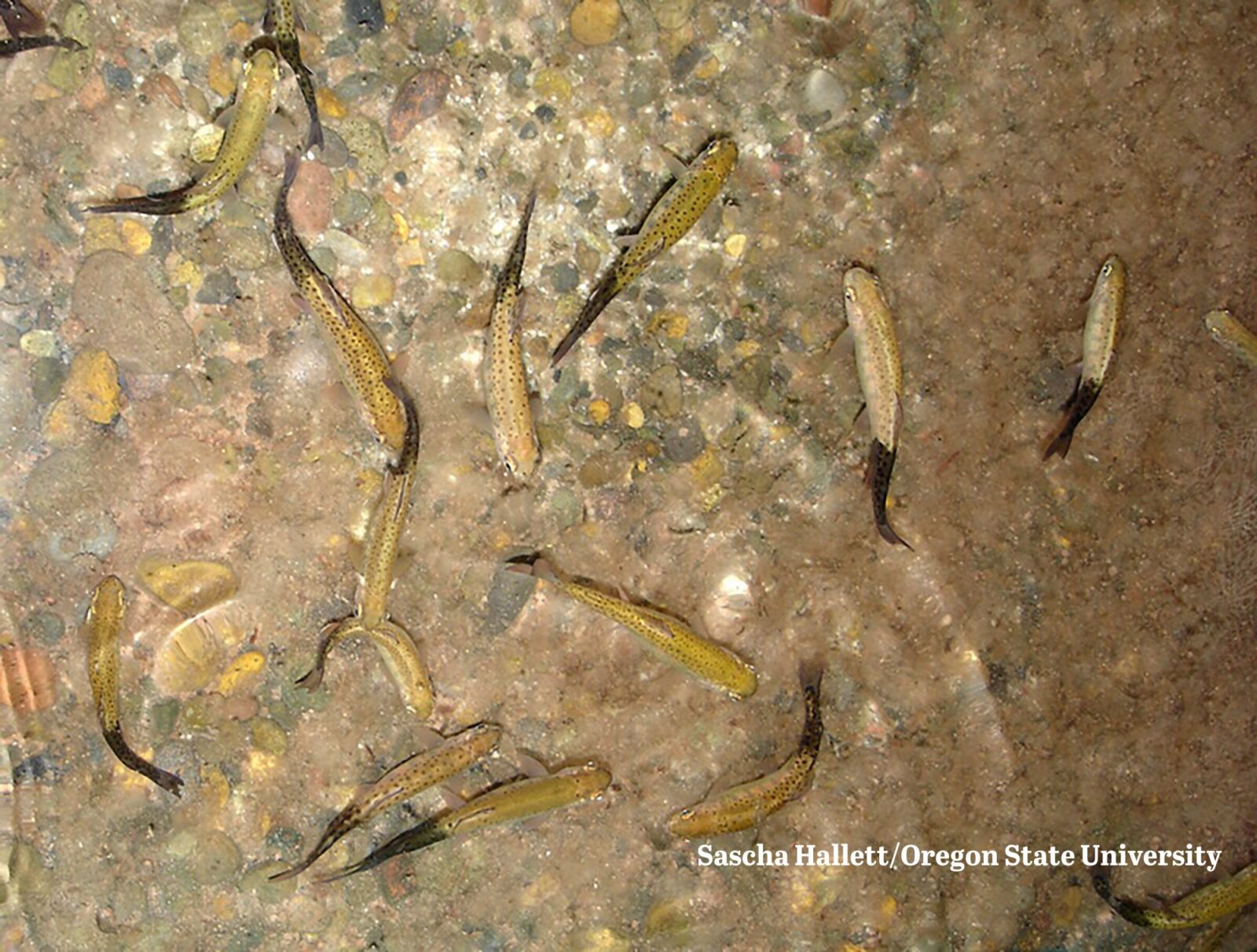By Alex McCrickard/DWR
Photos by Sascha Hallett/Oregon State University
Through recent testing, the Virginia Department of Wildlife Resources (DWR) has detected whirling disease at the state’s Marion Fish Hatchery in southwest Virginia. Unfortunately, DWR has had to euthanize 40,000 catchable trout to prevent the spread of whirling disease.
What is whirling disease?
Whirling disease is caused by a microscopic parasite, Myxobolus cerebralis. This parasite only impacts fish from the trout and salmon family: Salmonidae. This parasite penetrates the cartilage tissue of a trout’s head and spine, multiplying rapidly and causing skeletal deformities. Trout with whirling disease can show spinal deformities or a blackened tail, which can impact swimming ability and feeding habits. Some infected fish swim in a circular motion, giving the disease its “whirling” name. However, fish showing these distinct symptoms have not been seen in the wild or at state hatcheries in Virginia.

Fish showing symptoms of whirling disease can have bent, deformed tails. These fish were photographed during disease research at Oregon State University. Photo by Sascha Hallett/Oregon State University
Where did whirling disease come from?
Myxobolus cerebralis, the microscopic parasite that causes whirling disease, is native to Europe. The parasite’s presence in North America was first detected in 1958 in Pennsylvania. Since the 1950s, the parasite has continued to spread and has been detected in more than 20 states. Myxobolus cerebralis has been in Virginia now for approximately three decades; however, the extent of the parasite in the wild is unknown. While there are currently no documented negative impacts in Virginia, this parasite does have the potential to impact both wild and stocked trout populations.
How does DWR detect whirling disease in state hatcheries?
DWR’s stringent fish-health protocols involve regular testing at state hatcheries to look for pathogens that are potentially harmful to hatchery-raised and wild fish. The parasite that causes whirling disease is routinely tested for at DWR’s coldwater hatcheries.
Why does DWR not stock whirling disease-positive fish?
DWR does not stock whirling disease-positive trout in an effort to prevent the spread of whirling disease. Stocking whirling disease-positive trout may introduce the parasite that causes the disease to new waterbodies in Virginia. The parasite could then spread from hatchery trout to wild trout, which could have the potential to negatively impact Virginia’s trout fisheries.
The impacts of whirling disease can vary from system to system. Some fisheries might be able to cope with the disease, while others might see significant negative impacts. In the mid-1990s, Montana’s famous Madison River experienced devastating impacts after the introduction of whirling disease. In some stretches of the river, rainbow trout populations declined by approximately 90 percent. Other western rivers experienced outbreaks of the disease in the mid-1990s, such as Colorado’s famed Gunnison River. These instances put whirling disease on the radar of every fish and wildlife agency in the country.

These rainbow trout being studied at Oregon State University show the black tail symptom of whirling disease. Photo by Sascha Hallett/Oregon State University
Could whirling disease impact Virginia’s native brook trout?
Whirling disease has the potential to impact all salmonids, including brook trout. Studies have shown that rainbow trout tend to be the most susceptible salmonid to the disease. The DWR’s proactive approach in handling whirling disease-positive fish is aimed at protecting Virginia’s wild and native trout populations. The agency’s biosecurity protocols limit the spread of disease by restricting movement of trout across the commonwealth.
Can humans get whirling disease?
No, humans can’t get whirling disease. The parasite does not infect humans, even if a person eats infected fish.
Can other species of fish get whirling disease?
The parasite that causes whirling disease is specialized and only uses fish from the Salmonidae family as a host. Other species of fish cannot become infected with the parasite and disease.
How is DWR mitigating against whirling disease?
DWR is implementing measures to reduce the future impact of this parasite on trout production. The agency will continue to implement routine testing for this parasite. Infected groups of trout will be removed from the population. Additionally, DWR has made infrastructure improvements at state coldwater hatcheries to make the environment less hospitable for the parasite. DWR is currently evaluating other strategies, including additional infrastructure improvements, resistant strains of rainbow trout, and management strategies, to reduce the exposure of this parasite to hatchery-raised fish.
What is DWR doing to make up for the loss of fish from the Marion Hatchery?
DWR is working to reallocate fish as feasible to make up for shortfalls. Trout from other DWR coldwater hatcheries, such as Paint Bank and Wytheville, will be spread out throughout southwest Virginia in an effort to distribute fish out as evenly as possible across the state. With fewer fish being stocked this fall, it is likely that anglers could experience decreased catch rates with fewer stocked trout in the water.


